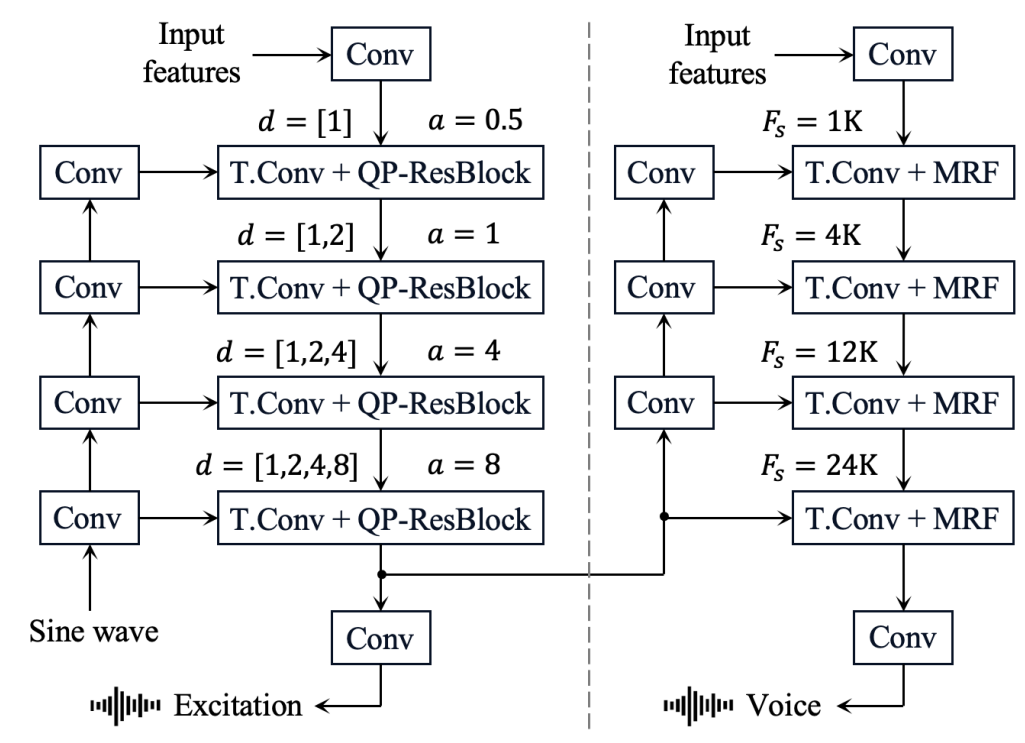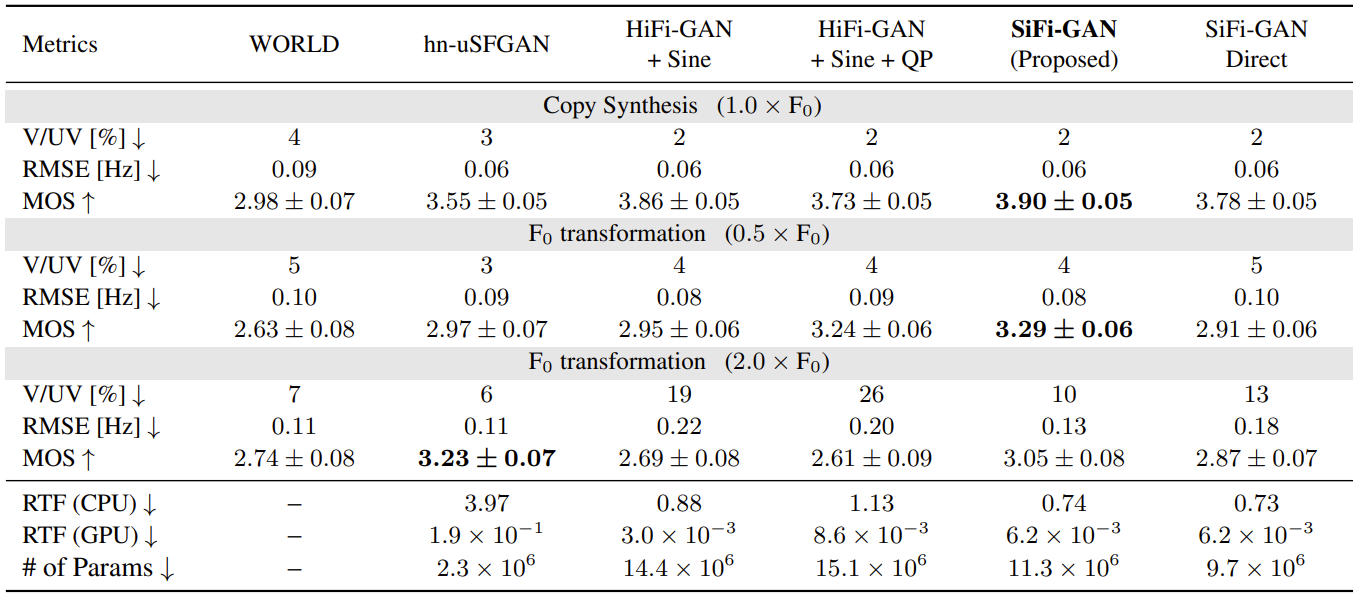티스토리 뷰
Paper/Vocoder
[Paper 리뷰] Source-Filter HiFi-GAN: Fast and Pitch Controllable High-Fidelity Neural Vocoder
feVeRin 2023. 11. 13. 11:18반응형
Source-Filter HiFi-GAN: Fast and Pitch Controllable High-Fidelity Neural Vocoder
- Unified Source-Filter GAN (USFGAN)은 source filter 이론을 도입하여 높은 음성 품질과 pitch 제어를 가능하게 함
- USFGAN은 높은 temporal resolution으로 인해 높은 계산 비용을 가짐
- Source-Filter HiFi-GAN
- HiFi-GAN에 source filter 이론을 도입한, 빠르고 pitch 제어가 가능한 neural vocoder
- Source excitation information에 resonance filter를 계층적으로 conditioning
- 논문 (ICASSP 2023) : Paper Link
1. Introduction
- Neural vocoder는 input acoustic feature를 기반으로 raw waveform을 생성하는 deep neural network
- 원하는 intonation과 pitch pattern을 유연하게 생성하기 위해서는 fundemental frequency (F0)의 controllability가 중요
- HiFi-GAN은 가장 많이 사용되는 neural vocoder 구조
- Low temporal resolution feature를 점진적으로 upsampling 하여 high temporal resolution raw waveform과 매칭시킴
- HiFi-GAN은 좋은 음성 품질을 보여주지만, F0의 controllability가 떨어짐
- HiFi-GAN의 F0 controllability 개선을 위해 Unified Source-Filter GAN (USFGAN)을 활용할 수 있음
- Quasi-Periodic Parallel WaveGAN의 generator를 source excitation network와 resonance filtering network로 분해
- 높은 temporal resolution input으로 인해 느린 합성 속도를 보임
-> 그래서 빠른 음성 합성과 F0 control이 가능한 Source-Filter HiFi-GAN을 제안
- Source-Filter HiFi-GAN
- HiFi-GAN에 source-filter 모델링을 도입한 구조
- Source-filter 이론의 pseudo cascade mechanism을 시뮬레이션하기 위한 두 개의 upsampling network
- Source-filter 모델링의 추가적인 계산 비용을 줄이기 위해 HiFi-GAN의 parameter를 pruning
< Overall of Source-Filter HiFi-GAN >
- 빠른 high-fidelity 합성과 F0 controllability를 확보한 HiFi-GAN 구조
- Source network와 Filter network를 통한 upsampling 과정
2. Baseline HiFi-GAN and USFGAN
- HiFi-GAN
- Multi-period, Multi-scale discriminator를 활용한 neural vocoder
- Generator는 mel-spectrogream을 입력으로 받고 이를 upsampling 함
- Target raw waveform의 temporal resolution과 Multi-receptive field fusion (MRF) module의 transposed convolution을 일치시킴
- MRF module은 여러 개의 residual block으로 구성됨
- Generator의 training objective $L_{G}$
: $L_{G}=L_{g,adv}+\lambda_{fm}L_{fm}+\lambda_{mel}L_{mel}$
- adversarial loss $L_{g, adv}$, feature matching loss $L_{fm}$, mel-spectral L1 loss $L_{mel}$
- $\lambda_{fm}$, $\lambda_{mel}$ : balancing hyperparameter
- Unified Source-Filter GAN (USFGAN)
- Source excitation regularization loss
- USFGAN은 source network의 출력의 regularization loss를 사용하여 single DNN을 source network와 filter network로 분해
- Linear predictive coding을 사용하여 output source excitation signal을 residual signal로 근사
: $L_{reg} = E_{x,c} [\frac{1}{N} || log \psi(S) - log \psi(\hat{S}) ||_{1}]$
- $x, c$ : 각각 ground truth speech, input features
- $\hat{S}, S$ : 각각 output source excitation signal, residual spectrogram의 spectral magnitude
- $\psi, N$ : 각각 해당 mel-spectrogram을 spectral magnitude로 변환하는 함수, mel-spectrogram의 차원수
- Pitch dependent excitation generation
- F0 extrapolation 성능을 향상하기 위해 Pitch-dependent Dilated Convolution Neural Network (PDCNN)을 활용
- $F_{s}, f_{t}, d$ : 각각 sampling frequency, time step $t$에서의 F0값, CNN의 constant dilation factor
- PDCNN에서 CNN의 dilation size는 $f_{t}$에 따라 각 $t$에 대해 동적으로 변화 - Time-variant dilation size $d_{t}$
: $d_{t} = \left\{\begin{matrix} |E_{t}| \times d \quad if \, E_{t} > 1 \\ 1 \times d \quad else \end{matrix}\right.$
- $E_{t} = F_{s}/(f_{t}\times a)$ : dense factor $a$에 의해 modulate 된 period length에 대한 proportional value
- Dense factor는 주어진 sampling frequency $F_{s}$로 표현가능한 최대 frequency를 제어 - 더 높은 F0 controllability를 위해 input으로 sine wave를 사용
- Sine wave는 periodic information을 제공하여 안정적인 학습과 F0 controllability를 제공함
- F0 extrapolation 성능을 향상하기 위해 Pitch-dependent Dilated Convolution Neural Network (PDCNN)을 활용
3. Source-Filter HiFi-GAN
- Generator Architecture
- Source excitation generation network
- Downsampling 1D CNN, transposed 1D CNN, quasi-periodic residual block (QP-ResBlock)을 활용해 source network를 구성
- Input sine wave는 resolution-matched periodic representation을 제공하기 위해 stride CNN을 통과함 - QP-ResBlock은 residual connection을 포함한 Leaky ReLU, PDCNN, 1D CNN으로 구성
- Source excitation signal은 QP-ResBlock의 최종 output을 regularize 하여 사용됨
- Downsampling 1D CNN, transposed 1D CNN, quasi-periodic residual block (QP-ResBlock)을 활용해 source network를 구성
- Resonance filtering network
- Filter network는 source network의 feature map이 transposed CNN의 output에 추가되는 것을 제외하면 HiFi-GAN의 generator와 동일
- Feature map은 sine embbedding CNN으로 구성된 additional downsampling CNN으로 처리됨
- 최종적인 음성은 filter network의 output으로 얻어짐 - Source network의 추가적인 계산 비용을 보정하기 위해 MRF module의 hyperparameter를 pruning
- Kernel size를 ${3,5,7}$로 줄여 합성 속도를 향상 - Downsampling CNN을 통해 QP-ResBlock의 output을 filter network에 공급함으로써 고주파 음성을 생성 가능
- Filter network는 source network의 feature map이 transposed CNN의 output에 추가되는 것을 제외하면 HiFi-GAN의 generator와 동일

- Training Criteria
- HiFi-GAN의 feature matching loss를 regularization loss로 대체
: $L_{G} = L_{g,adv}+\lambda_{mel}L_{mel} + \lambda_{reg}L_{reg}$
4. Experiments
- Settings
- Dataset : Namine Ritsu's Database
- Comparisons : WORLD, hn-uSFGAN, HiFi-GAN
- Objective Evaluation
- 합성 효율성을 확인하기 위해 real-time factor (RTF)와 parameter 수를 계산
- F0 controllability를 확인하기 위해 log F0 (RMSE), voice/unvoiced decision error rate (V/UV)를 조사 - 제안된 Source-Filter HiFi-GAN (SiFi-GAN)이 F0 controllability 측면에서 WORLD, hn-uSFGAN과 비슷한 성능을 달성
- 합성 속도 측면에서 hn-uSFGAN과 비교하면 더 적은 hyperparameter 사용과 RTF 향상을 보임
- HiFi-GAN과 비교하여도 빠른 합성 속도를 보임

- Subjective Evaluation
- 합성 결과에 대한 Mean Opinion Score (MOS) 평가
- SiFi-GAN이 음성 품질 측면에서도 좋은 성능을 보임 - Ablation Study
- QP-ResBlock의 source excitation representation을 downsampling 하지 않고 바로 filter network에 전달한 SiFi-GAN Direct와 SiFi-GAN을 비교
- SiFi-GAN Direct은 고주파 구성요소를 제대로 합성하지 못함
- Learnable downsampling CNN이 포함된 source network는 temporal resolution에 대한 tractable hierarchical harmonic information을 제공한다고 볼 수 있음

반응형
'Paper > Vocoder' 카테고리의 다른 글
댓글

